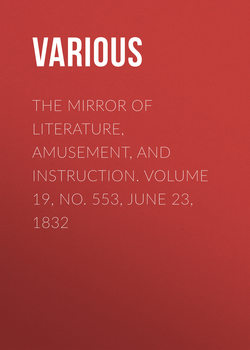The Mirror of Literature, Amusement, and Instruction. Volume 19, No. 553, June 23, 1832

Реклама. ООО «ЛитРес», ИНН: 7719571260.
Оглавление
Various. The Mirror of Literature, Amusement, and Instruction. Volume 19, No. 553, June 23, 1832
DUNHEVED CASTLE, CORNWALL
THE LATE MR. COLTON
NAPOLEON AT ST. HELENA
SCRIPTURAL HERALDRY
ANECDOTE GALLERY
HOBBES AT CHATSWORTH.6
MANNERS & CUSTOMS OF ALL NATIONS
ANCIENT PASTIMES
ORIGIN OF THE ARTILLERY COMPANY
HINDOO BURIAL SERVICE
ORIGIN OF THE ACADEMY DELLA CRUSCA
ANGLO-SAXON DRESS
THE SELECTOR; AND LITERARY NOTICES OF NEW WORKS
ARLINGTON,
SCRIPTURAL ANTIQUITIES
SPIRIT OF DISCOVERY
SPIRIT OF THE PUBLIC JOURNALS
THE COURT OF EGYPT. A SKETCH
NOTES OF A READER
SPANISH SUPERSTITION
CHARACTER OF ISABEL OF SPAIN
THE GATHERER
Отрывок из книги
These mouldering ruins occupy the crest of the hill, upon which stands the town of Launceston, near the centre of the eastern side of the county of Cornwall. They are the works of a thousand years since, when might triumphed over right with an unsparing hand, and when men perpetrated by fire and sword millions of murders, which, through the ignorance and credulity of their fellow creatures, have been glossed over with the vain glory of heroism.
The ancient name of Launceston was Dunheved, or the Swelling Hill; its present appellation, according to Borlase, the antiquarian illustrator of Cornwall, signifies, in mixed British, the Church of the Castle. The latter structure is the most important object in the town, to which, in all probability, it gave origin. The remains surround a considerable extent of ground, and prove it to have been a very strong and important fortress. Borlase, who examined the building with great attention about the middle of the last century, thus describes it:—
.....
The building of Dunheved Castle has been generally attributed to William, Earl of Moreton and Cornwall, the son and heir of Robert, Earl of Moreton, to whom 288 manors in this county were given by William the Norman. "But this opinion is most probably erroneous, as the style of workmanship exhibited in several parts of the remains, is apparently of a much earlier date. The walls of the keep, in particular, have every appearance of being considerably more ancient; and from a retrospective view of the events that have happened in this county, the conjecture appears to be fully warranted, that its foundation is as remote as the time of the Britons, who would undoubtedly endeavour to defend their territory both from Roman and Saxon usurpation, by fortifying the more advanced and important situations. The most therefore that can with certainty be attributed to the above earl, is the repairing and extending the fortifications. Carew, in his Survey of Cornwall, published in 1602, mentions the finding about sixty years before, 'of certain leather coins in the castle walls, whose fair stamp and strong substance till then resisted the assaults of time.' These singular coins, if they had been preserved or their impressions had been copied, might have thrown some light on the age of the building, as money of similar substance was employed by Edward I. in erecting Caernarvon Castle in Wales, 'to spare better bullion,'1 Some Roman coins have likewise, according to Borlase, been found in this neighbourhood; so that it is not unlikely that the Romans had possession of this fortress, which, from its situation near the ford of the river Tamar, was a fort of great importance. The earliest historical documents that are known concerning the castle, mention the displacing of Othomarus de Knivet, its hereditary constable, for being in arms against the Conqueror. It was then, as before mentioned, given to Robert, Earl of Moreton, whose son William, kept his court here. From him it reverted to the crown, but continued attached to the earldom of Cornwall till Edward III. when it was constituted and still continues, part of the inheritance of the Duchy. In Leland's time, several gentlemen of the county held their lands by castle-guard, being bound to repair and defend the fortifications of this castle.2 During the civil wars, this fortress was garrisoned for the king, and was one of the last supports of the royal cause in this part of the county."3
The reader may more than once have noticed our predilection for illustrating the castellated antiquities of Britain in our pages. We have a threefold object in this choice: first, the architectural investigation of these structures is of untiring interest; the events of their histories are so many links in the annals of our country; while they enable us to take comprehensive glances of the domestic manners of times past, and by contrasting them with the present, to appreciate the peaceful state of society in which we live.
.....